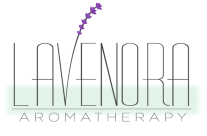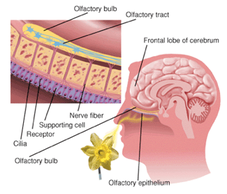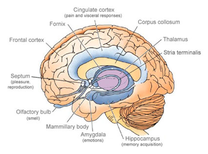How does Aromatherapy Work?
|
Our nose (olfactory system) is picking up scents (aromas) or odors every day. Our mind connects these scents with either neutral, positive, or negative feelings and emotions. Thus a scent functions as a chemical messenger in our brain, which is able to distinguish the difference between 10,000 different scents. Some scents we may be aware of on the conscious level while others correspond directly with our subconscious mind.
The image to the right illustrates how the scent of a flower travels up through the nose. The receptors and cilia in our nose break down the scent into chemicals that are then transported to our brain via the supporting cells, nerve fibers, and the olfactory bulb. The frontal lobe "translates" the message of the chemicals and in our mind we "know" the scent is coming from a flower. |
|
The process, of course, is much more complicated and as you can see from the image on the left, the brain has different areas of functioning. In aromatherapy, the olfactory bulb is responsible for our sense of smell. Neurotransmitters are messengers within our brain. These "messengers" bring a messege from one part of the brain to another part of the brain. The hippocampus (memory formation, organizing & storing information) corresponds with the amygdala (seat of emotions) which in turn correspond with the frontal cortex (logical thinking). Through this form of teamwork, we form memories and are able to retrieve these memories again.
|
Aromatherapy supports all areas of functioning of the brain. Through the use of essential oils, we are able to trigger certain responses in our brain. For example, Lavender essential oil has calming, soothing, and relaxing qualities whereas Peppermint essential oil is uplifting and stimulates our memory.
In addition, aromatherapy works on a vibrational level. Our body is made up of 65% water and our brain is 90% water. Diffusing essential oils, receiving a massage with essential oils, using skin products (e.g. cream, lotion) with essential oils, using a blend with essential oils - all allow the molecules of the particular essential oil to enter our body and our blood stream. As soon as an essential oil enters our blood stream, the function (benefit, or properties) of that particular essential oil (e.g. anti-inflammatory or calming) "becomes imprinted throughout the water-body" aka the blood stream, and "set off all kinds of chemical reactions." Essential oils leave the body rather quickly yet "the keys are turned in the locks, their jobs are done, and they can leave." Meaning, the natural healing abilities of the body have been turned on.
Reference: The Fragrant Mind by Valery Ann Worwood
In addition, aromatherapy works on a vibrational level. Our body is made up of 65% water and our brain is 90% water. Diffusing essential oils, receiving a massage with essential oils, using skin products (e.g. cream, lotion) with essential oils, using a blend with essential oils - all allow the molecules of the particular essential oil to enter our body and our blood stream. As soon as an essential oil enters our blood stream, the function (benefit, or properties) of that particular essential oil (e.g. anti-inflammatory or calming) "becomes imprinted throughout the water-body" aka the blood stream, and "set off all kinds of chemical reactions." Essential oils leave the body rather quickly yet "the keys are turned in the locks, their jobs are done, and they can leave." Meaning, the natural healing abilities of the body have been turned on.
Reference: The Fragrant Mind by Valery Ann Worwood



